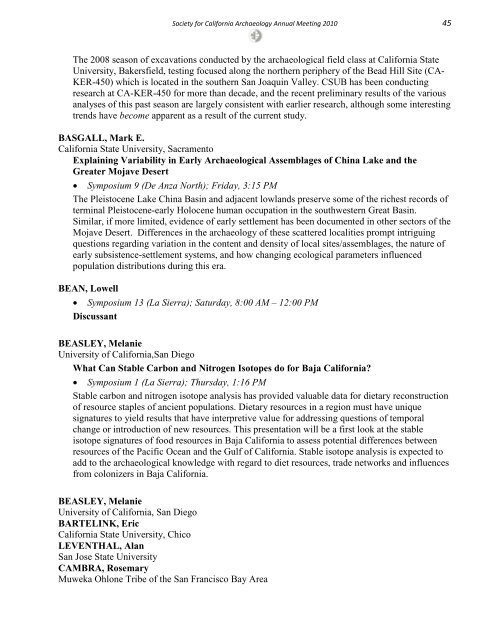Society for California Archaeology 2010 Annual Meeting
Society for California Archaeology 2010 Annual Meeting
Society for California Archaeology 2010 Annual Meeting
You also want an ePaper? Increase the reach of your titles
YUMPU automatically turns print PDFs into web optimized ePapers that Google loves.
<strong>Society</strong> <strong>for</strong> Cali<strong>for</strong>nia <strong>Archaeology</strong> <strong>Annual</strong> <strong>Meeting</strong> <strong>2010</strong> 45<br />
The 2008 season of excavations conducted by the archaeological field class at Cali<strong>for</strong>nia State<br />
University, Bakersfield, testing focused along the northern periphery of the Bead Hill Site (CA-<br />
KER-450) which is located in the southern San Joaquin Valley. CSUB has been conducting<br />
research at CA-KER-450 <strong>for</strong> more than decade, and the recent preliminary results of the various<br />
analyses of this past season are largely consistent with earlier research, although some interesting<br />
trends have become apparent as a result of the current study.<br />
BASGALL, Mark E.<br />
Cali<strong>for</strong>nia State University, Sacramento<br />
Explaining Variability in Early Archaeological Assemblages of China Lake and the<br />
Greater Mojave Desert<br />
• Symposium 9 (De Anza North); Friday, 3:15 PM<br />
The Pleistocene Lake China Basin and adjacent lowlands preserve some of the richest records of<br />
terminal Pleistocene-early Holocene human occupation in the southwestern Great Basin.<br />
Similar, if more limited, evidence of early settlement has been documented in other sectors of the<br />
Mojave Desert. Differences in the archaeology of these scattered localities prompt intriguing<br />
questions regarding variation in the content and density of local sites/assemblages, the nature of<br />
early subsistence-settlement systems, and how changing ecological parameters influenced<br />
population distributions during this era.<br />
BEAN, Lowell<br />
• Symposium 13 (La Sierra); Saturday, 8:00 AM – 12:00 PM<br />
Discussant<br />
BEASLEY, Melanie<br />
University of Cali<strong>for</strong>nia,San Diego<br />
What Can Stable Carbon and Nitrogen Isotopes do <strong>for</strong> Baja Cali<strong>for</strong>nia?<br />
• Symposium 1 (La Sierra); Thursday, 1:16 PM<br />
Stable carbon and nitrogen isotope analysis has provided valuable data <strong>for</strong> dietary reconstruction<br />
of resource staples of ancient populations. Dietary resources in a region must have unique<br />
signatures to yield results that have interpretive value <strong>for</strong> addressing questions of temporal<br />
change or introduction of new resources. This presentation will be a first look at the stable<br />
isotope signatures of food resources in Baja Cali<strong>for</strong>nia to assess potential differences between<br />
resources of the Pacific Ocean and the Gulf of Cali<strong>for</strong>nia. Stable isotope analysis is expected to<br />
add to the archaeological knowledge with regard to diet resources, trade networks and influences<br />
from colonizers in Baja Cali<strong>for</strong>nia.<br />
BEASLEY, Melanie<br />
University of Cali<strong>for</strong>nia, San Diego<br />
BARTELINK, Eric<br />
Cali<strong>for</strong>nia State University, Chico<br />
LEVENTHAL, Alan<br />
San Jose State University<br />
CAMBRA, Rosemary<br />
Muweka Ohlone Tribe of the San Francisco Bay Area

















